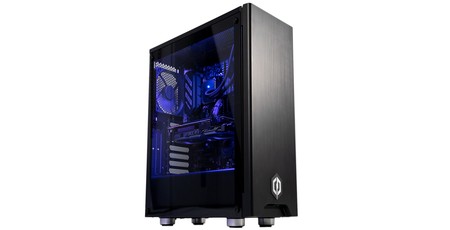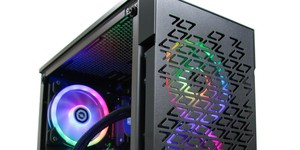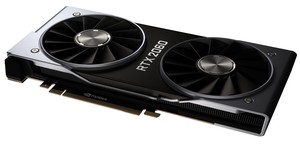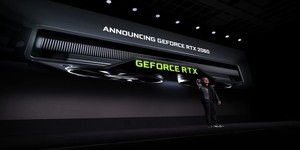
Manufacturer: CyberpowerPC UK
UK price (as reviewed): £1,948.80 (inc. VAT)
US price (as reviewed): N/A
Ask any hardware reviewer, and they’ll tell you that the second half of this year has been exceptionally busy. Between second-generation Ryzen Threadripper, 9th Gen Intel Core, and of course the divisive debut of Nvidia GeForce RTX hardware, there’s been a lot to cover, but with the bulk of critical launches now behind us (for now), it’s time to take a look at what system integrators have been doing with all the new kit lining their shelves. First up is the CyberpowerPC Infinity X99 RTX, which is based on the latest Intel Z390 chipset rather than the much older X99 one as the name might seem to imply.

The system doesn’t come cheap, but given it’s packing a Core i7-9700K and GeForce RTX 2080 (roughly £1,100 at retail combined), that’s hardly surprising. Cyberpower is banking on £2,000 being something of a sweet spot for a premium gaming rig. The exact configuration we were sent comes in £50 below this, but Cyberpower has one of the most flexible online configuration engines going, so there’s plenty of scope to add or subtract from that.

With so much of the budget already allocated to the CPU and GPU, Cyberpower has had to be more frugal than you might expect when dropping nearly £2,000. The Carbide 275R chassis, for example, is decidedly budget friendly, but we found it to be a solid if unexciting foundation for a system in our review. You get dust filters in the right places, dual USB 3.0 ports up front, and decent build quality.

Tempered glass nets you a good view of the clean internals, which have been spruced up here with the inclusion of two RGB LED strips (front- and top-mounted) that provide great illumination for the internals with a nice variety of colours and effects. This is in fact the only RGB hardware, and it’s controlled by a separate remote control rather than via the motherboard.

The MSI Z390-A Pro is again a budget-conscious choice, being as it is one of the least expensive motherboards for this chipset. The specs are predictably unexciting, therefore, but you do get USB 3.1 Gen 2 Type-A and Type-C connectivity on the back. However, only two of the remaining USB ports are USB 3.0, and the onboard audio is the ageing Realtek ALC892 codec. There’s also no SLI support, as the second PCIe x16 slot only has four available lanes, and no Wi-Fi either.
The Core i7-9700K has eight cores but lacks Hyper-Threading so is limited to eight simultaneous threads. As you'll know from our review, we're not particularly fond of this CPU. If heavily multi-threaded workloads are common for you, it’s far better either to save up for the dominating Core i9-9900K or spend considerably less cash and opt for a Ryzen 7 2700X, which is nearly always faster in multi-threaded workloads and not that far behind in games. And even if gaming is a big focus, the Core i7-8700K (fewer cores but more threads) is just as potent a CPU as this one but cheaper. The Core i9-9900K is an available option for this PC, and so is the Core i7-8700K, but Cyberpower is evidently offering the Core i7-9700K at a discount, as selecting the previous generation CPU actually results in a price increase. You'll need to select another PC entirely if you pursue the Ryzen route, meanwhile.
The CPU is predictably paired with 16GB of 3,000MHz DDR4, but less predictable was the lack of any overclock. While non-overclockable 9th Gen CPUs are still yet to arrive, this is a poor choice from CyberpowerPC; in our opinion, Z-series motherboard plus K-series CPU has to equal an overclock, and this is nearly always the case for prebuilt systems from competitors. True, better boosting means gains are more marginal these days, but there’d be little disadvantage to applying an all-core overclock of at least 4.9GHz (matching the peak single-core boost frequency). Cyberpower does offer two levels of overclocking in its configurator, but you have to pay, which is a bit cheeky at this price level – it’s trivially easy to do these days.

The RTX 2080 GPU is very powerful, dealing out GTX 1080 Ti levels of performance in normal games while also supporting Deep Learning Super Sampling and real time ray tracing in the small handful of games that support these features currently. Cyberpower’s card of choice is the MSI Ventus, which runs at stock speeds but does at least feature a custom dual-fan cooler (not semi-passive, sadly) and a backplate. It’s mostly neutral colour-wise, but it does have a few green highlights.

A 250GB 970 Evo NVMe M.2 SSD is the primary drive, backed up by a 2TB HDD. The motherboard lacks an M.2 heatsink, and 500GB would be a much nicer capacity at this price, but again Cyberpower seems to have been wary of the £2,000 price tag. You can switch to a 500GB WD Blue NVMe M.2 SSD for less than £50 extra, though, which would be a wise move in our opinion.

The CPU is cooled by a Cooler Master Seidon 240V, with the 240mm radiator front-mounted with its single row of fans acting as case intakes. These are complemented by the single rear case fan, with no others added – a basic but adequate airflow arrangement. All fans are connected to the motherboard; the rear fan is fixed speed, but the front ones respond to CPU temperature changes.
Powering everything is the Corsair CX750. In terms of capacity, it has more than enough for what’s inside, but otherwise it’s decidedly unexciting since it carries only an 80 Plus Bronze rating and has no modular cables.

Aesthetically, the Infinity X99 RTX is a bit bland but inoffensive. There isn’t much of a colour scheme, since most of the hardware is black or dark brown other than the aforementioned green highlights. However, this does make sense given the inclusion of RGB strips (easily turned off), as it avoids colour clashing. Pleasingly, the cable routing job is up to scratch as well, with Cyberpower having made use of the right-angled USB 3.0 header and bundling and tying the non-modular PSU cables behind the motherboard tray and in the lower chamber.
The BIOS is up to MSI’s usual high standards, so we’ve no complaints there. Cyberpower correctly applied the XMP memory profile, and saved the profile to ensure easy recovery. The Windows 10 Home installation comes without any bloatware at all - another positive.
The three-year warranty terms are decent enough, covering six months collection and return. Some competitors are now able to offer a full three years for every facet, though.
Specifications (as reviewed)
- CPU Intel Core i7-9700K (stock speed)
- CPU cores/threads Eight/eight
- Memory 16GB (2 x 8GB) Corsair Vengeance LPX 3,000MHz DDR4
- Graphics MSI GeForce RTX 2080 Ventus 8GB (3 x DisplayPort 1.4a, 1 x HDMI 2.0b, 1 x USB Type-C VirtualLink)
- Motherboard MSI Z390-A Pro
- Storage 1 x 250GB Samsung 970 Evo M.2 SSD, 1 x 2TB Seagate Barracuda HDD
- Case Corsair Carbide Series 275R, 2 x RGB LED strip with RF controller
- Dimensions (mm) 225 x 460 x 455 (W x D x H)
- Cooling Cooler Master Seidon 240V
- PSU Corsair CX750 750W (80 Plus Bronze, non-modular)
- Networking 1 x Gigabit LAN
- Audio 7.1-channel Realtek ALC892 (onboard)
- Operating system Windows 10 Home 64-bit
- Audio and USB Ports Rear: 1 x USB 3.1 Type-A, 1 x USB 3.1 Type-C, 2 x USB 3.0, 2 x USB 2.0, 6 x audio jacks; Front: 2 x USB 3.0, headphone, microphone
- Warranty Three years (six months collect and return, two years parts, three years labour)

MSI MPG Velox 100R Chassis Review
October 14 2021 | 15:04








Want to comment? Please log in.